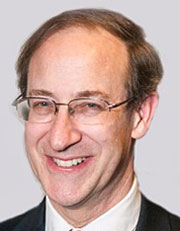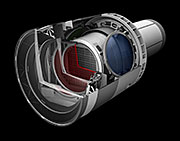Tony Heinz, a scientist known for exploring the properties of nanoscale materials and developing important new tools for that exploration, has joined DOE’s SLAC National Accelerator Laboratory as a professor of photon science and Stanford University as a professor of applied physics. He will also lead the SLAC Chemical Sciences Division.
While his position became official in January, he will spend the next few months wrapping up his research at Columbia University, where he has been the David Rickey Professor of Physics and Electrical Engineering, and moving operations into lab space being readied on the Stanford and SLAC campuses.
“As someone who grew up in Northern California and attended Stanford and Berkeley, I am really looking forward to being back in the Bay Area,” Heinz said. “It’s a beautiful part of the world, a very exciting one in terms of science and technology, and also one with family and friends. I am delighted to have the opportunity to join the research activities at SLAC and Stanford.”
Full Story
Feature
The Large Synoptic Survey Telescope, whose construction is led by DOE’s SLAC National Accelerator Laboratory, is currently in the advanced design phase. Placed in Cerro Pachon, Chile, it will enable the world's largest imaging survey, taking repeated images of the southern sky beginning in 2020.
"LSST will truly be a next-generation survey: It will surpass preceding surveys in terms of data size in its first few months of operation," said University of Pennsylvania astrophysicist Bhuvnesh Jain, spokesperson for the Dark Energy Science Collaboration of the LSST.
Innovative DESC software, developed at DOE’s Fermi National Accelerator Laboratory in collaboration with other institutions, will enable scientists to explore the many astronomical mysteries that the LSST will open up. At SC14, the supercomputing conference held in November, Fermilab scientists achieved a milestone with a successful demonstration run of the DESC analysis framework software.
Full Story
See also…
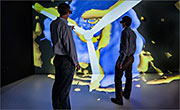 Wind energy is blowing away skeptics—it's so close to achieving cost parity with fossil fuels that just a little extra efficiency is all that is likely needed to push it into the mainstream and past the Energy Department's goal of 20% wind energy by 2030.
Wind energy is blowing away skeptics—it's so close to achieving cost parity with fossil fuels that just a little extra efficiency is all that is likely needed to push it into the mainstream and past the Energy Department's goal of 20% wind energy by 2030.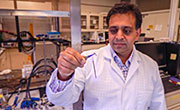 The Defense Advanced Research Projects Agency (DARPA) recently selected Lawrence Livermore National Laboratory (LLNL) to join a collaborative research team that intends to build the world’s first neural system to enable naturalistic feeling and movements in prosthetic hands.
The Defense Advanced Research Projects Agency (DARPA) recently selected Lawrence Livermore National Laboratory (LLNL) to join a collaborative research team that intends to build the world’s first neural system to enable naturalistic feeling and movements in prosthetic hands.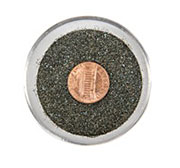 One of the keys to the successful deployment of chemical looping technologies is the development of affordable, high performance oxygen carriers. One potential solution is the naturally-occurring iron oxide, hematite. “Hematite is pretty cheap,” says Doug Straub, Technical Coordinator for the National Energy Technology Laboratory’s Chemical Looping Combustion (CLC) projects and the just-completed Industrial Carbon Management Initiative (ICMI). “You just dig it out of the ground and run it through a screen.” That affordability makes hematite attractive as an oxygen-carrier material, but high performance at the conditions imposed by the chemical looping process is also important. Researchers at the DOE lab are investigating how to enhance hematite-based oxygen carriers so they can stand up to high reactor temperatures. Oxygen carriers also need to be resilient in the face of frequent impacts with reactor walls, with each other, and (in coal-burning reactors) with coal particles. Researchers are also improving oxygen carriers so that they more completely combust the fuel.
One of the keys to the successful deployment of chemical looping technologies is the development of affordable, high performance oxygen carriers. One potential solution is the naturally-occurring iron oxide, hematite. “Hematite is pretty cheap,” says Doug Straub, Technical Coordinator for the National Energy Technology Laboratory’s Chemical Looping Combustion (CLC) projects and the just-completed Industrial Carbon Management Initiative (ICMI). “You just dig it out of the ground and run it through a screen.” That affordability makes hematite attractive as an oxygen-carrier material, but high performance at the conditions imposed by the chemical looping process is also important. Researchers at the DOE lab are investigating how to enhance hematite-based oxygen carriers so they can stand up to high reactor temperatures. Oxygen carriers also need to be resilient in the face of frequent impacts with reactor walls, with each other, and (in coal-burning reactors) with coal particles. Researchers are also improving oxygen carriers so that they more completely combust the fuel. 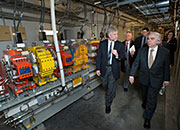 From the floor to the rafters, the world's most advanced synchrotron light source was filled with hundreds of people—including U.S. Department of Energy (DOE) Secretary Ernest Moniz, U.S. Senator Chuck Schumer, U.S. Representatives Lee Zeldin and Kathleen Rice, and a number of other distinguished guests—who gathered as Secretary Moniz dedicated the National Synchrotron Light Source II (NSLS-II) at Brookhaven Lab on Feb. 6.
From the floor to the rafters, the world's most advanced synchrotron light source was filled with hundreds of people—including U.S. Department of Energy (DOE) Secretary Ernest Moniz, U.S. Senator Chuck Schumer, U.S. Representatives Lee Zeldin and Kathleen Rice, and a number of other distinguished guests—who gathered as Secretary Moniz dedicated the National Synchrotron Light Source II (NSLS-II) at Brookhaven Lab on Feb. 6.